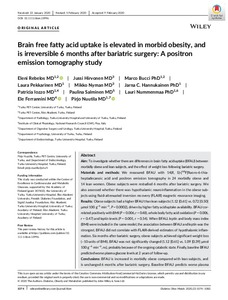Brain free fatty acid uptake is elevated in morbid obesity, and is irreversible 6 months after bariatric surgery: A positron emission tomography study
Eleni Rebelos; Jussi Hirvonen; Marco Bucci; Laura Pekkarinen; Mikko Nyman; Jarna C. Hannukainen; Patricia Iozzo; Paulina Salminen; Lauri Nummenmaa; Ele Ferrannini; Pirjo Nuutila
https://urn.fi/URN:NBN:fi-fe2021042824473
Tiivistelmä
Aim
To investigate whether there are differences in brain fatty acid uptake (BFAU) between morbidly obese and lean subjects, and the effect of weight loss following bariatric surgery.
Materials and methods
We measured BFAU with 14(R, S)‐[18F]fluoro‐6‐thia‐heptadecanoic acid and positron emission tomography in 24 morbidly obese and 14 lean women. Obese subjects were restudied 6 months after bariatric surgery. We also assessed whether there was hypothalamic neuroinflammation in the obese subjects using fluid‐attenuated inversion recovery (FLAIR) magnetic resonance imaging.
Results
Obese subjects had a higher BFAU than lean subjects (1.12 [0.61] vs. 0.72 [0.50] μmol 100 g−1 min−1, P = 0.0002), driven by higher fatty acid uptake availability. BFAU correlated positively with BMI (P = 0.006, r = 0.48), whole body fatty acid oxidation (P = 0.006, r = 0.47) and leptin levels (P = 0.001, r = 0.54). When BFAU, leptin and body mass index (BMI) were included in the same model, the association between BFAU and leptin was the strongest. BFAU did not correlate with FLAIR‐derived estimates of hypothalamic inflammation. Six months after bariatric surgery, obese subjects achieved significant weight loss (−10 units of BMI). BFAU was not significantly changed (1.12 [0.61] vs. 1.09 [0.39] μmol 100 g−1 min−1, ns), probably because of the ongoing catabolic state. Finally, baseline BFAU predicted worse plasma glucose levels at 2 years of follow‐up.
Conclusions
BFAU is increased in morbidly obese compared with lean subjects, and is unchanged 6 months after bariatric surgery. Baseline BFAU predicts worse plasma glucose levels at follow‐up, supporting the notion that the brain participates in the control of whole‐body homeostasis.
Kokoelmat
- Rinnakkaistallenteet [27094]
